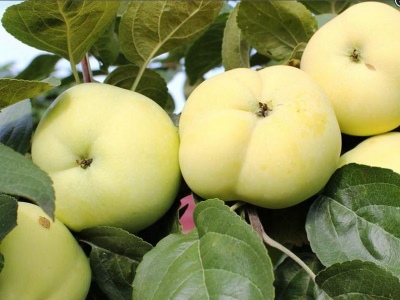
- Authors: S.P. Kedrin (Samara Experimental Station for Gardening)
- Taste: sweet and sour
- Scent: weak
- Fruit weight, g: 79-90
- Fruit size: below average
- Yield: at the age of 8-11 years, on average for 4 years, a yield of 62 c / ha was obtained
- The beginning of fruiting varieties: for 4-5 years
- Ripening terms: summer
- Removable maturity: August 5-15
- Keeping quality: 10-12 days
One of the most common fruit trees with a huge variety of varieties is the apple tree. This fruit crop can please any gardener. Apple trees can boast not only the taste of their fruits, but also unpretentious care. Papirovka's daughter is one of these varieties.
Breeding history of the variety
The domestic variety was bred by breeders of the gardening station in Samara in 1937. Her employee Kedrin S.P. worked on the breeding of the apple tree. For selection, the varieties Papirovka and Anis aliy were taken.
Description of the variety
Papirovka's daughter is a summer variety that begins to bear fruit very early. These wonderful qualities were inherited from his parents. Tall trees reach heights up to 7.5-8 meters. The dense crown of the tree has a round or wide pyramidal shape. The branches are arranged in several tiers. Each of them is represented by 5-6 powerful branches that grow to the trunk at an angle of 55-60 degrees. Young shoots are slightly pubescent, have an average thickness, and are colored brown-gray. The leaves are wide, slightly narrowed. Light pink flowers form on a ringlet, fruit twig, or spear.
Features, pros and cons
The main feature of the variety is the growth of branches, which grow by an average of 50 cm during the year.
The advantages of this apple tree are:
early summer ripening of fruits;
juicy and dense pulp;
excellent taste of apples;
high productivity;
unpretentious care.
There is only one drawback - with abundant fruiting, the fruits may shrink.
Ripening and fruiting
The apple tree brings the first fruit 3-4 years after planting. Fruit ripening begins after July 15, in the northern regions it occurs in August. Fruiting is annual. Ripe fruits stick firmly to the branches and practically do not crumble, which makes it easy for gardeners to harvest.
Growing regions
Papirovka's daughter is grown almost everywhere in Russia. The main growing region is considered to be the Central Region of Russia. And also widespread culture in the Urals and in the Middle Volga region.
Due to its frost resistance, the variety has proven itself well in the northern regions.
Yield
Trees of the Papirovka Daughter variety give high yields. Up to 55 kg of delicious fruits can be harvested from one tree. In the southern regions, the yield is even higher. There, gardeners collect up to 130 kg of apples from one tree.
Fruits and their taste
The apples are medium in size, their weight ranges from 79 to 90 g. In the southern regions, the fruits are larger. The apples are angular or round in shape, often oval, slightly flattened specimens can be found.
The apples taste sweet, with sourness, which gives them sophistication and original taste. Juicy and firm flesh is covered with a medium-density skin. Ripe fruits take on a light green hue.

Growing features
Particular attention must be paid to correct tree pruning and crown formation.
Young seedlings are planted in spring or early autumn. This is necessary in order for the root system to get stronger before the onset of frost. For planting, choose a sunny area that is protected from the winds. Fertile land should be provided with watering. The trees are planted at a distance of 5.5-6 meters from each other. For good fruiting, groundwater should not approach the root system closer than 1 meter.
For planting, holes are dug 65 cm deep and 60 cm wide. 1/2 of a bucket of humus is poured onto the bottom of the pit; peat or mineral fertilizers can be used. Wood ash will also be a good fertilizer. The seedling is placed in a hole and covered with earth. Then watered abundantly, and cover the ground with dry grass. This method will help retain moisture in the root system for longer.



Pollination
The tree is pollinated with the help of insects. Bright fragrant flowers attract the attention of not only bees and wasps, but also other insects.
Top dressing
Very often trees of this variety are fertilized with foliar dressing. This is a new method in which fertilizers are delivered through the leaves.
Nitrogen-containing fertilizers, which should be applied in the spring, are suitable as a root top dressing. It is good to use rotted manure.

Frost resistance
The Daughter Papirovka variety perfectly tolerates frosts down to -26 degrees. In the southern regions, no shelter is needed.

Diseases and pests
The foliar feeding system not only helps the tree to obtain nutrients, but also protects against diseases and insect pests. After harvesting, the tree is sprayed with a solution of urea (5-6%). This contributes to the resistance of the culture to various types of scab.
In case of damage to the shoots with calcareous chlorosis, ferrous sulfate is used (0.6-0.8%).
A solution of zinc sulphate is used to combat small leaves and leaf fall.
In case of dying off of the ends of the branches, the tree is sprayed with boric acid or brown. This process is performed during flowering or bud formation.

The apple tree is a popular fruit crop among gardeners. It can be found in many summer cottages. But at the same time, such trees are often affected by various diseases. It is very important to recognize the disease in time and carry out the necessary procedures for a speedy recovery.Otherwise, the fruits will be spoiled, and the tree itself may die altogether.












































































